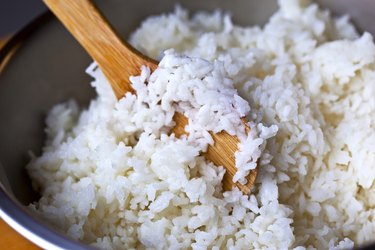
You can fix wet cooked rice: If the rice is hard, cook it a little longer. If there is extra water, let the wet rice rest for a bit once you're done cooking it. This mushy rice fix can solve most of your problems with fluffy rice that's still a little too moist to serve.
Make Sure It's Well Cooked
Video of the Day
The first thing you should do is taste the rice. While the rice should have a tender texture, it shouldn't be mushy. If you detect any hardness, then it's a good idea to put it back on the stove so it can cook some more. Make sure to place the lid on the pot and to set the heat on low to allow the rice to simmer for a few more minutes so that it cooks fully.
Video of the Day
It's a good idea to use a timer when you're cooking rice. This way, you'll know exactly how long the rice has been cooking. White rice should be fully cooked in 20 minutes, according to UT Extension Fresh Plate.
Brown rice, on the other hand, could take up to 50 minutes. Wild rice, which is actually a seed and isn't in the same family as white and brown rice, takes approximately 40 to 45 minutes to cook.
Read more: How Is White Rice Healthy for Our Body?
Get Rid of Excess Water
So you've checked the rice to ensure that it's cooked and, just in case it's not, you've given it some more time to properly cook. The next step of the mushy rice fix is to drain out the excess water.
Rice should never have standing water when fully cooked, so make a note not to use as much water next time. Ideally, you should follow package directions where cooking times and amounts of water and rice are concerned. If you're using bulk rice, there are some rules of thumb for water-to-rice ratios for different varieties of rice:
- For white rice, the water-to-rice ratio is 2 cups water to 1 cup rice.
- For brown rice, the water-to-rice ratio is 2 1/2 cups water to 1 cup rice.
- For wild rice, the water-to-rice ratio is 3 cups water to 1 cup rice.
Using these ratios, in addition to letting the rice cook fully, help ensure that all the water is gone by the time the rice is ready.
Allow the Rice to Sit
Chances are, even if you try your best to drain off the excess water, you won't be able to get rid of all of it. There may still be some left in the wet rice. If so, just let the rice sit untouched for a while.
Now that the rice is ready, set it aside without the lid on the pan. Don't touch the rice at all for at least five minutes. Just let it sit. This is an important resting period for the rice, as it ensures that any water remaining will either evaporate or be absorbed.
The more water, the longer it will take. However, if you drained as much as you could at the beginning, then it shouldn't take too long for what's left to evaporate or be absorbed.
Another way to get rid of excess water in rice is to drain the excess water out and then spread the rice on a baking sheet. Place in an oven heated to 350 F for five minutes, and this will dry up the extra water, suggests Food Network chef Alton Brown.
Read more: Is Rice Acid or Alkaline?
Tips for Perfect Rice
Utah State University Cooperative Extension suggests fluffing the rice before serving. For this, you'll need a fork. This is done to encourage the rice to separate and also to check whether it's still mushy. If it is, repeat the last step of the mushy rice fix and give the rice some additional time.
A useful tip to remember is that careful preparation from the start helps to ensure that your rice is fluffy and delicious. The Harvard T.H. Chan School of Public Health points out that you should thoroughly rinse rice in cool water before cooking to get rid of excess starch and any dust or other contaminants. You can also opt to soak it to decrease cooking time and stickiness.
You can remedy some rice errors by boiling salted water in a large pot and then adding the rice after the water has begun to boil. Using a large pot instead of a small one allows the rice to cook more evenly and quickly.
Remember to use the correct rice-to-water ratios when deciding how much salted water to boil. After adding the rice, reduce the heat, cover the pot tightly with a lid and resist the urge to lift the lid until the rice is ready to fluff.
- Simply Healthy Family: "How to Fix Watery Rice: Four Simple Solutions"
- Alton Brown: "How to Fix Rice"
- Utah State University Extension: "Rice"
- Harvard T.H. Chan School of Public Health: "Rice"
- UT Extension Fresh Plate: "Rice"
- Red Lake Nation Foods: "Cooking Instructions — Minnesota Cultivated Wild Rice"